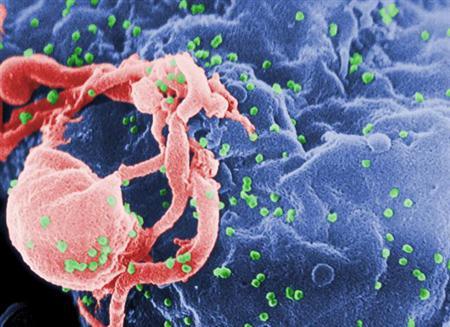Sunday Times 2
Scientists ‘delete’ HIV virus from human DNA
Once HIV conquers a human cell, it will stay there forever.
It inserts its deadly genome permanently into its victims’ DNA, forcing them to require medical treatment for the rest of their life.
But now, for the first time, researchers in Philadelphia have found a way to completely delete HIV from human cells by ‘snipping’ them out.
The team of Temple University School of Medicine said the breakthrough marks the first successful attempt to eliminate latent HIV-1 virus from human cells – and could be a cure for other latent infections.

For the first time, researchers in Philadelphia have found a way to completely delete the HIV virus (pictured) from human cells by 'snipping' them out (AFP)
‘This is one important step on the path toward a permanent cure for AIDS,’ said Kamel Khalili, PhD, Professor and Chair of the Department of Neuroscience at Temple.
‘It’s an exciting discovery, but it’s not yet ready to go into the clinic. It’s a proof of concept that we’re moving in the right direction,’ he added,
In a study published by the Proceedings of the National Academy of Sciences, Dr Khalili and colleagues detail how they created molecular tools to delete the HIV-1 proviral DNA
When deployed, a combination of a DNA-snipping enzyme called a nuclease and a targeting strand of RNA called a guide RNA (gRNA) hunt down the viral genome and remove the HIV-1 DNA.
From there, the cell’s gene repair machinery takes over, soldering the loose ends of the genome back together – resulting in virus-free cells.
‘Since HIV-1 is never cleared by the immune system, removal of the virus is required in order to cure the disease,’ explained Dr Khalili.
These molecular tools also hold promise as a therapeutic vaccine; cells armed with the nuclease-RNA combination proved impervious to HIV infection.
Worldwide, more than 33 million people have HIV.
Although highly active antiretroviral therapy (Haart) has controlled HIV-1 for infected people in the developed world over the last 15 years, the virus can rage again with any interruption in treatment.
‘The low level replication of HIV-1 makes patients more likely to suffer from diseases usually associated with ageing,’ Dr Khalili said.
These include cardiomyopathy – a weakening of the heart muscle – bone disease, kidney disease, and neurocognitive disorders.
‘These problems are often exacerbated by the toxic drugs that must be taken to control the virus,’ Dr Khalili added
Dr Khalili’s lab engineered a 20-nucleotide strand of gRNA to target the HIV-1 DNA and paired it with a DNA-sniping enzyme called Cas9 and used to edit the human genome.
‘We want to eradicate every single copy of HIV-1 from the patient. That will cure AIDS. I think this technology is the way we can do it,’ Dr Khalili said.
© Daily Mail, London

